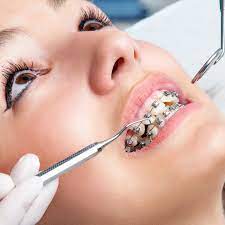Causey Orthodontics Can Be Fun For Everyone
Causey Orthodontics Can Be Fun For Everyone
Blog Article
The Greatest Guide To Causey Orthodontics
Table of ContentsAn Unbiased View of Causey OrthodonticsExcitement About Causey OrthodonticsLittle Known Questions About Causey Orthodontics.Facts About Causey Orthodontics RevealedExcitement About Causey Orthodontics
Ignoring occlusal partnerships, it was normal to remove teeth for a range of dental concerns, such as malalignment or overcrowding. The principle of an intact teeth was not extensively appreciated in those days, making bite relationships seem unnecessary. In the late 1800s, the principle of occlusion was important for producing trustworthy prosthetic replacement teeth.As these principles of prosthetic occlusion progressed, it came to be a vital device for dentistry. It remained in 1890 that the work and effect of Dr. Edwards H. Angle began to be really felt, with his contribution to modern-day orthodontics particularly significant. Focused on prosthodontics, he showed in Pennsylvania and Minnesota prior to directing his interest towards oral occlusion and the therapies needed to preserve it as a regular condition, therefore coming to be known as the "dad of modern orthodontics".

The principle of excellent occlusion, as proposed by Angle and integrated right into a classification system, enabled a change towards treating malocclusion, which is any deviation from regular occlusion. Having a full set of teeth on both arches was highly looked for after in orthodontic therapy due to the requirement for precise relationships in between them.
Our Causey Orthodontics Statements
As occlusion came to be the essential top priority, facial percentages and aesthetic appeals were neglected - emergency orthodontist near me. To attain suitable occlusals without using outside pressures, Angle proposed that having best occlusion was the ideal way to get optimal facial visual appeals. With the death of time, it came to be fairly apparent that even a remarkable occlusion was not appropriate when thought about from a visual factor of sight
Charles Tweed in America and Raymond Begg in Australia (who both studied under Angle) re-introduced dentistry extraction right into orthodontics throughout the 1940s and 1950s so they might boost face esthetics while also ensuring better security concerning occlusal connections. In the postwar duration, cephalometric radiography started to be made use of by orthodontists for determining changes in tooth and jaw placement created by development and treatment. It ended up being obvious that orthodontic therapy could readjust mandibular growth, bring about the development of practical jaw orthopedics in Europe and extraoral force measures in the United States. Nowadays, both practical home appliances and extraoral tools are used around the globe with the objective of changing growth patterns and kinds. As a result, going after true, or at the very least enhanced, jaw relationships had ended up being the main purpose of treatment by the mid-20th century.
The Buzz on Causey Orthodontics
 The American Journal of Orthodontics was created for this objective in 1915; before it, there were no scientific goals to adhere to, nor any type of precise classification system and braces that did not have functions. Up until the mid-1970s, dental braces were made by wrapping steel around each tooth. With advancements in adhesives, it ended up being feasible to instead bond metal brackets to the teeth.
The American Journal of Orthodontics was created for this objective in 1915; before it, there were no scientific goals to adhere to, nor any type of precise classification system and braces that did not have functions. Up until the mid-1970s, dental braces were made by wrapping steel around each tooth. With advancements in adhesives, it ended up being feasible to instead bond metal brackets to the teeth.Andrews offered an informative definition of the suitable occlusion in irreversible teeth. This has actually had meaningful effects on orthodontic treatments that are carried out regularly, and these are: 1. Appropriate interarchal connections 2. Right crown angulation (idea) 3. Right crown disposition (torque) 4. No turnings 5. Limited call factors 6. Apartment Contour of Spee (0.02.5 mm), and based upon these principles, he uncovered a therapy system called the straight-wire device system, or the pre-adjusted edgewise system.
The benefit of the layout depends on its bracket and archwire mix, which calls for just very little wire bending from the orthodontist or clinician (orthodontist services). It's appropriately named hereafter attribute: the angle of the port and thickness of the brace base inevitably figure out where each tooth is positioned with little demand for additional manipulation
The 6-Second Trick For Causey Orthodontics
Both of these systems used identical brackets for each and every tooth and necessitated the flexing of an archwire in three aircrafts for locating teeth in their desired positions, with these bends dictating best placements. When it comes to orthodontic devices, they are split into 2 types: detachable and repaired. Detachable devices can be handled and off by the patient as called for.

Hence, nearly all modern set appliances can be taken into consideration variations on this edgewise appliance system. Early 20th-century orthodontist Edward Angle made a major payment to the world of dental care. He created four unique device systems that have been used as the basis for numerous orthodontic therapies today, barring a few exemptions.
The 5-Minute Rule for Causey Orthodontics

The cord ended in a string, and to relocate it ahead, an adjustable nut was used, which permitted a boost in circumference. By ligation, each specific tooth was connected to this expansive archwire (cheapest orthodontist near me). Due to its minimal variety of activity, Angle was not able to achieve exact tooth positioning with an E-arch
These tubes held a firm pin, which could be rearranged at each visit in order to move them in position. Referred to as the "bone-growing home appliance", this gizmo was thought to urge much healthier bone development due to its possibility for transferring pressure directly to the roots. Executing it confirmed problematic in fact.
Report this page